Nose: Yeasty dough, wheat.
Palate: Textbook “whisky”. Water brings out a hit of nuts.
Comments: Very boring, but very drinkable.
Of malt whisky, cider and other drinkables. Carpe aqua vitae.
Nose: Yeasty dough, wheat.
Palate: Textbook “whisky”. Water brings out a hit of nuts.
Comments: Very boring, but very drinkable.
Tomorrow, 28 September 2013, it’s open day at Fary Lochan, and the Danish distillery releases its first whisky. The very first bottle will be auctioned off, and stock holders have been able to pre-order. At 1500 DKK for 50 cl the whisky had better deliver…
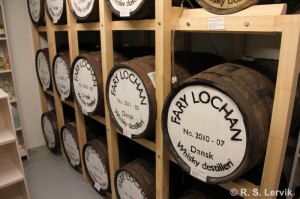 We visited Fary Lochan in 2011. At that point they sold newmake and bottles with newmake and an added bit of charred Danish oak. The theory was that the spirit would mature in the bottle. The mini-stave is of a size calculated to the proportion of exposure in a cask, but the destillery manager, Jens-Erik Jørgensen, said that they had noticed that the “maturation” was much quicker than expected and they expected that the “whisky” would reach its peak some time during 2013 or 2014. We decanted 20 cl from our bottle before the summer, and we’re planning to decant another 10 or 20 before the end of the year. The dram I’m tasting tonight is from the bottle cotaining the “stave”.
We visited Fary Lochan in 2011. At that point they sold newmake and bottles with newmake and an added bit of charred Danish oak. The theory was that the spirit would mature in the bottle. The mini-stave is of a size calculated to the proportion of exposure in a cask, but the destillery manager, Jens-Erik Jørgensen, said that they had noticed that the “maturation” was much quicker than expected and they expected that the “whisky” would reach its peak some time during 2013 or 2014. We decanted 20 cl from our bottle before the summer, and we’re planning to decant another 10 or 20 before the end of the year. The dram I’m tasting tonight is from the bottle cotaining the “stave”.
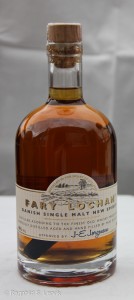 Nose: Newmake, a little paint stripper. Water brings out spice and tart apples, but the paint stripper remains.
Nose: Newmake, a little paint stripper. Water brings out spice and tart apples, but the paint stripper remains.
Palate: Weird. Newmake with oakiness. It tastes a bit like newly varnished wooden floors (not that I’ve actually tried to eat a newly varnished floor, mind you). Water releases a hint of spice.
Comments: The nose is just horrible. The palate is a little better, even if I’m sticking to the varnished floors. It also appears rather unbalanced, the wood is not well integrated with the spirit.
I remember the “clean” newmake as pretty good, so my conclusion is that though the idea of a stave in the bottle is an entertaining one, it does not work the way it was intended. We’ve got a bottle of the untarnished (I almost wrote “unvarnished”) newmake as well, but it’s in the cupboard that’s so child-proofed even we can’t open it (well, not without undoing the child-prrofing permanently). But once I can get at it I’ll write notes, and perhaps revisit this, too. We’ll put off decanting any more, I think, at this stage it’s not worth keeping.
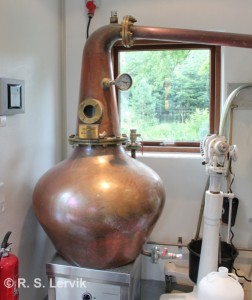
Finished in ex-raspberry wine casks (“Vilkdhallon” means “wild raspberries”).
Nose: Alcohol. After a while peach and lemon, and quite a bit of vanilla.
Palate: The cask is present, even if I doubt “raspberry” would have been my first thought had I had this blind. I get more of a rhubarb, actually. And citrus. A lot of vannilin, so one suspects relatively new oak. In the background I find raspberry jam.
Comments: This stretches the concept of whisky, really, something it shares with a few other “finishes”. This does not make it a bad product, in fact it is rather nice, but it raises issues with branding.
Arve says it was much more raspberry-like from a newly opened bottle, my sample has had some air.
 Nose: Vademecum. With a little water it softens into a more normal spicyness with a hint of menthol.
Nose: Vademecum. With a little water it softens into a more normal spicyness with a hint of menthol.
Palate: Vademecum on the palate as well, with underlying malt and some oaky bitterness.
Comments: Needs some time in the glass. First impression is much like with a lot of other non-Scottich whiskies, viz “it’s nice, but is it whisky?”, but with some water and air I’m beginning to think it’s pretty good. Not “Norvege douze points” good, but a very respectable first attempt.
This is a note for a Mackmyra private cask. Friends of ours had a share in a cask, and had just received some bottles when we visited them.
Mackmyra has offered private casks since day one. Several Scottish distilleries have been doing the same thing for years, but as far as I know Mackmyra were the first to offer small casks, of around 30 litres. This means the maturation period is much shorter. A private cask, at Mackmyra anyway, does not come cheap, but then part of the point is to help fund the running of the distillery in the period where they are spending rather than earning money. You are also buying not just the spirit, but a whole package: You can be present when your cask is filled, you get yearly samples – and you can visit the cask to receive them if you like – and when the spirit is ready to be bottled you can pay for a package of hotel, whisky dinner and tasting. All in all it is possible to spend quite a lot of money this way, but you’re bound to have fun doing it.
The whisky our frinds had was of the smoky variety, and had been matured in a 30 litre ex-sherry cask for five years.
Nose: Clear smoke, some sherry notes, spices – coriander seeds and cardamum – dark chocolate and a sweet tarry note.
Palate: Nice smokiness, some driend fruits. A rather sharp side-note.
Comments: A lovely nose, and a nice enough palate. No reason to be disappointed in this. Worth the money? Well, perhaps not. But subtrackt the expenses for the experience in itself and you’re left with a decent whisky and a good story to serve alongside.
If you’re tempted to spend some of your hard-earned cash in this way, visit mackmyrareserv.de and play around with spirit and cask types
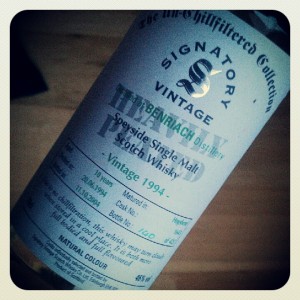 10 år gammel, destillert 20.06.1994, tappet 11.10.2004, hogshead fat nummer 1643.
10 år gammel, destillert 20.06.1994, tappet 11.10.2004, hogshead fat nummer 1643.
Nose: “Heavily peated” is no lie, the peat smoke hits you even as you’re pouring your dram. In addition I find oranges and grapefruit and something juniper bush’esque. With water the fruit turns to apricots or peaches, but the smoke stays. It smells like a kiln.
Palate: Peat smoke and juniper wood. With water a fruitcakey sweetness appears.
Comments: A perfectly drinkable peated dram, but no stunner. Better on the nose than on the palate.
Distilled November 1992, bottled 2006. Casks numbered 8572 and 8574. 750 bottles from two hogsheads. Sample from, well, I cannot remember.
Nose: Dry wood, coriander, pears, cucumber.
Palate: Malt, vannilin, bitter almonds.
Comments: Takes a lot of water considering it’s only 43%. It’s always interesting to taste Mortlach from something other than ex-sherry casks, but this is not the best example I’ve had. A bit middling, both in terms of complexity and in terms of how the flavours push my buttons subjectively.
From a sherry hogshead, one of 264 bottles. A dreg, and it has been open for a while, so there may have been loss of aroma and flavour.
Nose: Apricots, baked apple (but no cinnamon). With a little water it provides a hint of smoke and cloves or even aniseed.
Palate: Faint smoke, heather honey, heather, spice (allspice and cloves), and peaches.
We visited my parents on Sunday and this was temptingly placed on the kitchen counter, so I grabbed the opportunity to write tasting notes for it. My mum was quite pleased with the purchase, complaining only that it seemed to disappear very quickly.
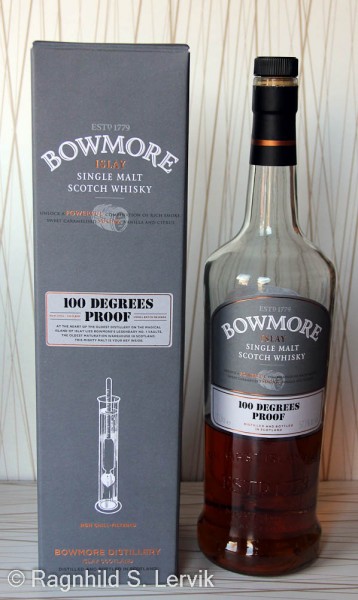
Nose: Orange peel, juniper berries, pine needles, surprisingly little smoke. Only with water does the smoke manifest, as well as green apples and (smoked) meat.
Palate: Warm peat smoke, salty sea, tar, orange, spice. With quite a bit of water I also get apples and spicy sponge cake.
Comments: I will definitely buy a bottle if I get the chance.